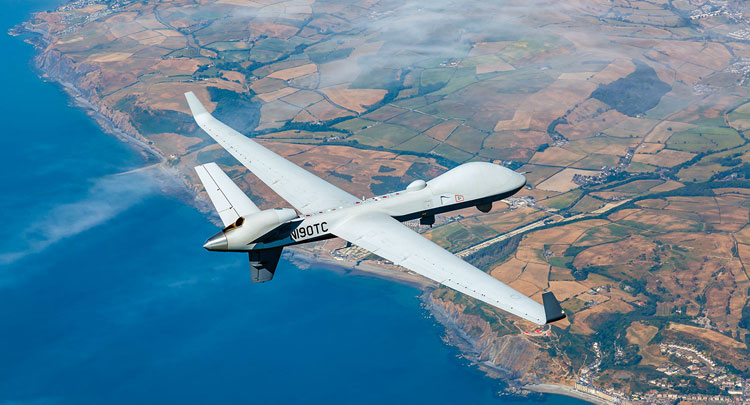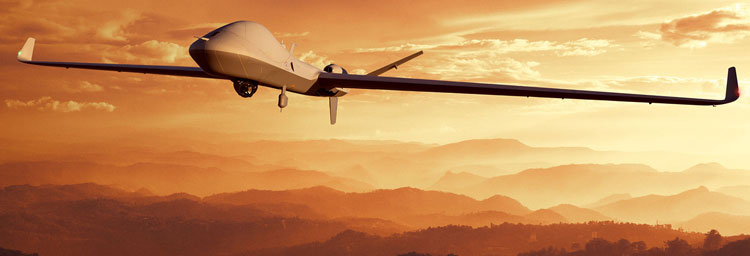INDIAN ARMED FORCES CHIEFS ON
OUR RELENTLESS AND FOCUSED PUBLISHING EFFORTS

SP Guide Publications puts forth a well compiled articulation of issues, pursuits and accomplishments of the Indian Army, over the years

I am confident that SP Guide Publications would continue to inform, inspire and influence.

My compliments to SP Guide Publications for informative and credible reportage on contemporary aerospace issues over the past six decades.
Indian Navy inducts SeaGuardian drones on lease

The Indian Navy has recently inducted two MQ-9B SeaGuardian drones on lease from the United States to carry out surveillance in the Indian Ocean Region. The drones,from the American firm General Atomics, are also likely to be deployed in Eastern Ladakh along the Line of Actual Control owing to the ongoing tensions between Indian and Chinese Army.
According to the reports the lease is for one year. Flying the Indian Navy logo, the drones reportedly arrived in India mid-November and are under full operational control of the Indian Navy which will have exclusive access to all the information that will be captured by the drone. All planning, execution and operations are to be with the Indian Navy while the Original Equipment Manufacturer (OEM) will play a support role for maintenance as laid down in the agreement, according to the available reports. The firm will only ensure availability, but the two MQ-9B SeaGuardians would be flown by Indian Navy personnel. A team from the firm however is reported to be currently in India as part of the deal for maintenance of the machines and to support the Indian Navy in operating and other technical concerns.
Flying the Indian Navy logo, the drones reportedly arrived in India mid-November and are under full operational control of the Indian Navy which will have exclusive access to all the information that will be captured by the drone.
“The two drones are the unarmed versions and have been inducted into flying operations on 21 November at Indian Navy base at INS Rajali. The drones arrived in India earlier this month,” a senior officer was quoted as saying.
The two MQ-9B SeaGuardian intelligence-surveillance-reconnaissance drones, which have endurance of flying for over 30 hours have already been reported to flying sorties over the Bay of Bengal. Reportedly, the SeaGuardian drones under are not weaponised, though the type is capable of being configured for anti-surface warfare, anti-submarine warfare and the airborne anti-mine capability.
General Atomics had earlier stated that the SeaGuardian RPAS features a multi-mode maritime surface-search radar with Inverse Synthetic Aperture Radar (ISAR) imaging mode, an Automatic Identification System (AIS) receiver, a High-Definition – Full-Motion Video sensor equipped with optical and infrared cameras. This sensor suite, augmented by automatic track correlation and anomaly-detection algorithms, enables real-time detection and identification of surface vessels over thousands of square nautical miles.

Specifically, the SeaGuardian’s onboard sensors include the GA-ASI Lynx® Synthetic Aperture Radar (SAR), a Raytheon Intelligence & Space SeaVue Expanded Mission Capability (XMC) radar, a Raytheon Intelligence & Space Multi-Spectral Targeting System, a Leonardo Electronic Support Measure (ESM)/Electronic Intelligence (ELINT) SAGE 750, a Shine Micro Automatic Identification System (AIS), an Ultra sonobuoy receiver and a General Dynamics Mission Systems-Canada sonobuoy processor.
General Atomics had earlier stated that the SeaGuardian RPAS features a multi-mode maritime surface-search radar with Inverse Synthetic Aperture Radar (ISAR) imaging mode, an Automatic Identification System (AIS) receiver, a High-Definition – Full-Motion Video sensor equipped with optical and infrared cameras.
According to the company’s data sheet, the drone can also “perform over-the-horizon long-endurance, medium-altitude Intelligence, Surveillance and Reconnaissance (ISR) missions.”
As part of its restructuring of the force to offset budgetary constraints, the Navy was reportedly on the look out to induct more unmanned solutions, both aerial and underwater. The drones will allow the navy to track various things and enhance the force’s ability with their long endurance.The Indian Navy is already using nine P-8I long-range surveillance planes.
A couple of months back, Ministry of Defence was reported preparing to acquire 30 General Atomics MQ-9B drones from the United States. This deal was valued at a cost of about $3 billion. The procurement of an initial lot of six Reaper Medium Altitude Long Endurance drones was cleared by the Ministry. From these six, two were to be for each the three forces (army, navy and air force).

Out of the 30 drones, six MQ-9s worth approximately $600 million were to be purchased and delivered within these months. The remaining 24 (eight for each service) were planned to be acquired over the next three years under an ‘option clause’ in the contract. The deal was first in the pipeline for 22 Sea Guardians for the Indian Navy in 2017. However, in 2018, this was converted into a tri-services acquisition by the government.
With the arrival of these two SeaGuardians, the Indian Navy has been made the lead service for this significant acquisition.
A couple of months back, Ministry of Defence was reported preparing to acquire 30 General Atomics MQ-9B Guardian drones from the United States. This deal was valued at a cost of about $3 billion. The procurement of an initial lot of six Reaper Medium Altitude Long Endurance drones was cleared by the Ministry. From these six, two were to be for each the three forces (army, navy and air force).
It is under the recently released Defence Acquisition Procedure-(DAP) 2020 and the Defence Procurement Manual -2009 that the option of leasing weapon systems has been provisioned. It also aids in saving funds and lets the vendor keep the responsibility of maintenance. DAP 2020 had introduced an option for leasing military platforms and this is reportedly the first defence system that has been taken on lease under it. The Chakra nuclear submarine from Russia is the only other defence equipment on lease.
A tri-service proposal to procure 10 Unmanned Aerial vehicles (UAV) for each Service from the U.S., including armed drones has been in the talks for some time now but budgetary concerns have been causing delay in the same, according to the reports. Reportedly, in 2018 the U.S. agreed to supply India with the Sea Guardians, but the high cost meant that the process had slowed down.At the dialogue with the U.S. last month, India had signed the last foundational agreement Basic Exchange and Cooperation Agreement for Geo-Spatial Cooperation (BECA), which simplifies such high- technology cooperation.The BECA is said to give India access to extremely accurate geo-spatial data, which will have major implications for a range of military aspects, such as giving Indian missiles a killer edge.





